Between 2022 and 2059 we are observing a cluster of Venus-Mars conjunctions in Saturn ruled Capricorn and Aquarius. The cluster occurs in 2 phases lasting 7 and 5 years, set 25 years apart.
This phase is noteworthy due to Saturn ruling 80% of conjunctions in the set. It is part of a repeat pattern that this report will introduce.
Venus and Mars conjunctions in Saturn ruled signs are relatively rare compared to others. This is another feature that makes these loaded Saturnine clusters very interesting to map and study from an astrological perspective.
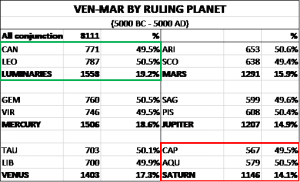
The 2022-2059 cluster and beyond
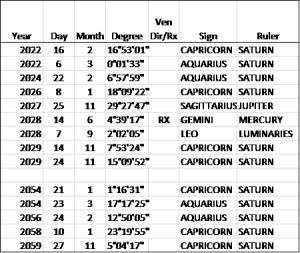
The pattern leads to another smaller cluster of consecutive conjunctions, observed 27 years later:

After this, the conjunctions will fall into 32-year gap sign-to-sign respectively, followed by a series of varied rhythmic patterns and some notable gaps where no conjunctions occur in the sign at all. This effectively means that some select generations will never witness a Venus-Mars conjunction in Capricorn for example. On the other hand, those alive today will have seen more than our fair share.
However, once it’s over, it’s truly over: after the 2022-2059 set is complete, there won’t be another one quite like it for about 800 years.
When it does happen, it won’t be an entirely comparable one, but will be close enough for perspective. Saturn rules 67% of conjunctions in this time-frame.
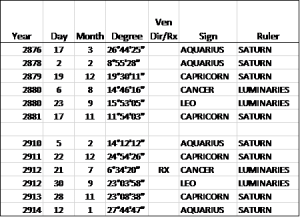
Another cluster will commence 333 years later, and that one actually matches the 2022 one, by proportion as well as in terms of phases and rhythm that follows it.
This means that there will be a total gap of 1148 years back-to-back between these 2 matching points in the Venus-Mars cycle. The sheer length of these periods makes the implications difficult to fully fathom. Especially when attempting to look forward:
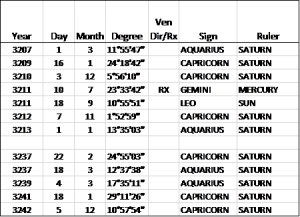
A very interesting thing to note is just how well this set matches the 2022 one – it even features a conjunction with Venus RX in Gemini.
Previous clusters in Saturn ruled signs
History is always the best place to start. And the more recent, the easier to reflect.
The most recent Saturnine Venus-Mars conjunction cluster similar to the 2022-2059 one took place only around 300 years ago. And yes, this one too featured a conjunction during a Venus RX in Gemini.
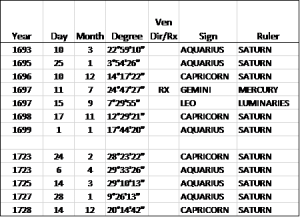
Just like the one in 2022, this one was followed by a mini-cluster (27 years later too) between 1755 and 1760, so definitely a fair match.
Looking across data between 5000 BC and 5000 AD helps put the sheer scope of these cycles and phases into perspective. The perspective being that they are marking entire epochs.
In the data set under study a cluster with this specific pattern occurred as follows:
- 4982 – 4945 BC
- 3797 – 3762 BC
- 2253 – 2216 BC
- 1036 – 1001 BC
- 807 – 842 AD
- 1693 – 1728 AD
- 2022 – 2059 AD
- 3207 – 3242 AD
(N.B. some clusters are omitted, including some that did not match the selected phase adequately enough to be included. Any other qualifying ones will be added to the main data set due by Spring 2022)
Defining epochs through the lens of Venus-Mars
Although their occurrence lacks apparent regularity (by our measure of time), there is an obvious and logical pattern.
Robert Blaschke, Michele Finey and Gary Caton all considered Venus-Mars cycle pattern irregularity in their respective work.
In his work, Caton explored overarching patterns and observed the possibility of framing two very distinct phases. In his essay “The 300 Year Venus-Mars Epoch” Caton suggests that the Venus-Mars epochs are separated into two intervals: Venus phase, lasting around 200 years and Mars phase taking approximately 100 years.
Among the time-periods he has identified is what he refers to as the “Era of General Crisis” taking place ~1648–1741. According to Caton this timespan frames one Mars period. Interestingly, this period coincides with the last Saturnine conjunction cluster in 1693-1728.
Further note that our current Saturn ruled cluster of 2022 – 2059 falls into another Mars period, as defined by Caton. He calls it the “Era of Cold Wars”, a period encompassing ~1947–2040.
It is probably pertinent to consider and explore the implications of a Saturn-heavy conjunction set as a notable chunk of the defined Mars era.
History is the best teacher, unfortunately recent events showed humanity is not a great student. Perhaps some day we will learn how to make the most of these intense spans, in more constructive, as opposed to destructive, ways.
1693 – 1728 cluster – historic events
Here are some history notes from the times surrounding the Venus-Mars conjunctions in that Saturn ruled cluster of 1693-1728 to help frame the possible implications or correlations.
The Rise of Slavery
Late 1600s to early 1700s were marked by a boom in slavery. The impact of this on humanity is still rippling through time.
“By 1675 slavery was well established, and by 1700 slaves had almost entirely replaced indentured servants.”
https://www.monticello.org/slavery/paradox-of-liberty/african-slavery-in-colonial-british-north-america/
A deeper study of this dramatic time in history of humanity is a topic for another article. Suffice to say that today, the wounds still fester as apparent in the fresh surge of revolt, termed simply as “BLM”. No three letters ever held so much pain.
It matters today that we put into perspective these timeframes and reflect on where we are and what we can do better to ensure that it becomes absolutely unthinkable that any human life should be deemed lesser. Until we achieve that, humanity will repeat old cycles of pain and injustice. Speaking of cycles and patterns here is another parallel:
War of the Grand Alliance
Another notable set of events that coincides with these times is the War of the Grand Alliance. It bears an uncanny resemblance to the current events in Ukraine, albeit with a different mix of actors and circumstances. Nonetheless, we are again witnessing an established (and expanding) alliance (NATO) forming a noose around another power on the grounds of expansionism. Saturnine energy fits nicely around the current political rhetoric in more ways than one. As it did back then:
“War of the Grand Alliance, (1689–97)Third major war of Louis XIV of France, in which his expansionist plans were blocked by an alliance led by Britain, the United Provinces of the Netherlands, and the Austrian Habsburgs.”
“The (original) league proved ineffective, but in 1690 Britain, Brandenburg, Saxony, Bavaria, and Spain, alarmed at Louis’s successes, joined with Leopold to form the Grand Alliance. As war broke out in Europe and in overseas colonies, including America (see King William’s War), Louis found his military inadequately prepared, and France suffered heavy naval losses.
In 1695 Louis started secret peace negotiations, which culminated in the Treaty of Rijswijk (1697). The underlying conflict between the Habsburg and Bourbon rulers and English-French conflicts remained unresolved and resurfaced four years later in the War of the Spanish Succession.”
https://www.britannica.com/event/War-of-the-Grand-Alliance
I will leave the conclusions on these parallels (as well as any forecasting) up to the reader and experts on the topic of geopolitics. Have we evolved enough to do better? I sure hope so. Before we go there is however one more angle to consider. What about the times there are no conjunctions in a Saturn-ruled sign? Namely Capricorn for instance:
Gap years
As mentioned earlier, just as there are clusters in signs, there are also periods when a sign is entirely absent from the Venus-Mars conjunction schedule. Although, like everything else in the mechanism, this is a matter of planetary trajectories, motion as well as the system we use to map the sky, it is perhaps just as worth exploring these gaps in terms of their astrological implications. To be able to study these here is a listing of them from the main data set:
18 gaps are recorded between 5000 BC and 5000 AD where Venus-Mars conjunctions in Capricorn were entirely missing.
As there are 567 conjunctions in Capricorn in the 10,000 year study period, we can say that there is approximately one gap per every 32 conjunctions, on average.
An average gap length is 78.7 years. Although they can range 40-121 years, the majority (78%) are under 100 years in duration.
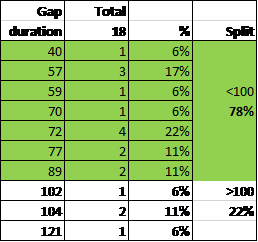
The gaps are spaced around 500 years apart in this sign.
Also sharing a list of the years when gaps end, along with the number of years to map back (as well as a column with timespan gap-to-gap.
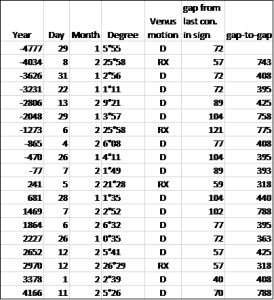
“The music is not in the notes, but in the silence between.”
Taking just the most recent gap ending in 1864 the above line by Mozart fits with eerie perfection. Mozart (born January 27, 1756, Salzburg, Austria —died December 5, 1791, Vienna) lived and died in the period immediately after the last Venus-Mars Saturnine cluster. He witnessed the silence of the early phases of the 77-year gap and I can’t help but wonder at the resonance.
Outside, this “silence” between conjunctions in Capricorn encompassed 1787-1864. During that time there were numerous important events.
For focus, let’s return to the topic of Saturn-ruled conjunctions coinciding with a surge in slavery: The 1800s on the other hand, were marked by the American Civil War, which of course led to the abolition of slavery in…1864.
“The 13th amendment, which formally abolished slavery in the United States, passed the Senate on April 8, 1864, and the House on January 31, 1865.”
Uncanny that it starts and ends with Saturn at the helm. Perhaps we would be wise to pay heed to the cycles ear-marked in any way by Saturn. There is much to learn from them.
For those interested in 1787 (the onset of the 77-year gap), here is just a fraction of relevant events in history. The conclusions are up to you.
- 1787: The United States Constitution is written in Philadelphia and submitted to the states for ratification.
- 1787: Freed slaves from London establish Freetown in present-day Sierra Leone.
- 1787–1792: Russo-Turkish War
- 1788–1790: Russo-Swedish War (1788–1790).
(Wikipedia)
Disclaimer: The author of this article is not a historian. This limited perspective is by no means an exhaustive study. The selections are made based on how closely they coincide with relevant dates and timelines from an astrological perspective. Further study of possible correlation between the highlighted planetary aspect, cycle/phase and historic events/timelines is needed before drawing firm parallels and conclusions.
This report was written with an aim to inspire further research and provide an additional angle on what is normally mapped using outer planet aspects and transits. I suspect that, when it comes to major world events and epochs, various inner planet synodic cycles tend to be in astrological agreement with major transits and aspects of outer planets.
What we know about the nature of Venus-Mars
Venus-Mars cycles are selected for study for their apparent “glitchy” nature as well as due to the astrological significations that we assign to them for thousands of years. As drivers of passionate pursuits and conquests but also associated strongly with themes of war and peace, this pair may be messy to study. However it can be crucial in that it reflects the spark of (and drive behind) most human pursuits. Venus-Mars aspects pack a powerful punch that, has been explored at length by Michele Finey in her book “The Sacred Dance of Venus and Mars”.
After exploring the parallels between Venus-Mars significations, as well as comparing the patterns formed by Venus-Mars as a virtual mirror-image of the pattern of the dance between Uranus and Pluto, she concludes:
“…as catalysts for change, the dynamic energy exchanged between Venus and Mars is just as potent as the combination of Uranus and Pluto. Since Venus and Mars aspects happen more frequently they will be felt more personally.”
(Finey, Michele. The Sacred Dance of Venus and Mars . The Wessex Astrologer)
I highly recommend her book to anyone seeking to grasp Venus-Mars cycles, as well as Gary P. Caton’s work on the cycles and epochs they are part of.
References:
- Finey, Michele. The Sacred Dance of Venus and Mars. The Wessex Astrologer.
- Blaschke, Robert P., Aberrations in the Venus-Mars Cycle, as published in TMA, 2010
- Caton, Gary P., the 300 Year Venus-Mars Epoch. (For links to a selection of Caton’s work please contact him directly on http://www.dreamastrologer.com/ )
About this work
This work is born out of an ongoing data study of Venus-Mars conjunctions distribution and cycles in the period between 5000 BC and 5000 AD.
I would like to extend my thanks to Petr from astro-seek.com for providing the extended data for this project and for his tireless efforts to provide the global astrology community with high quality data + tools for our various quests.
Sandra H.
About the author
Sandra Hill is a professional researcher and writer. She has devoted the last 10 years to the study of Western astrology.
Blog: www.skyunfolding.com



Comments are closed